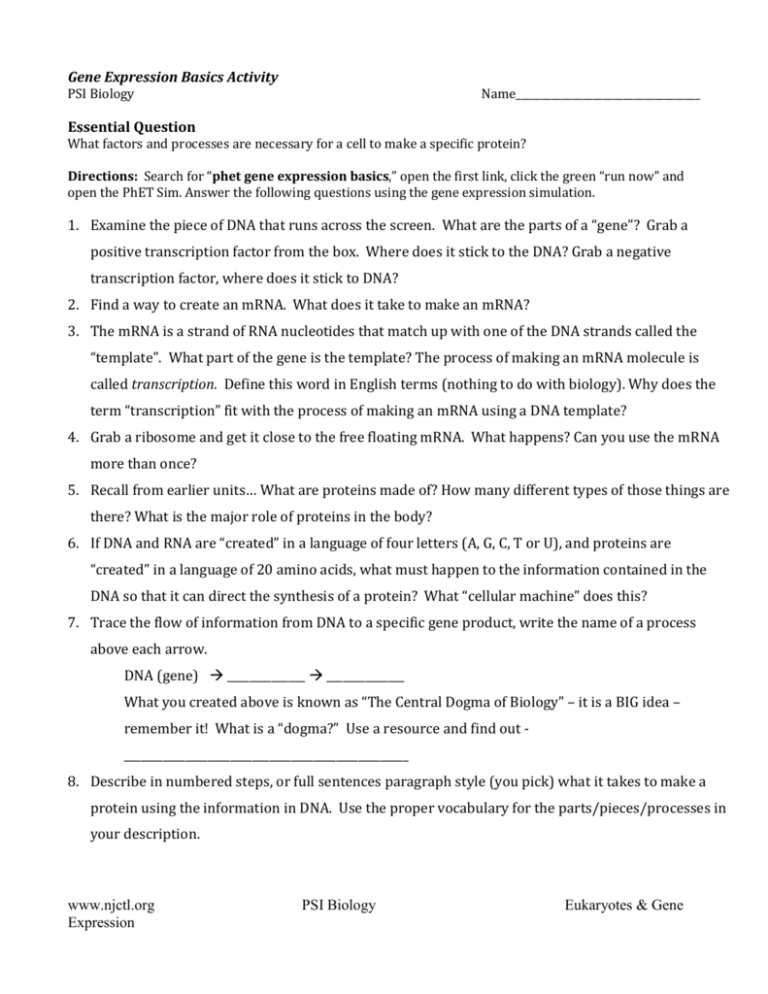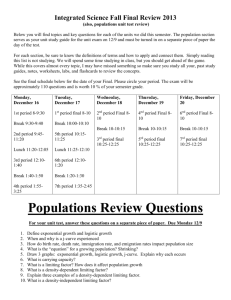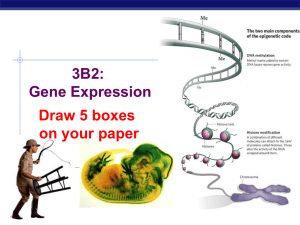Lab Science Name
advertisement

Gene Expression Basics Activity PSI Biology Name____________________________________ Essential Question What factors and processes are necessary for a cell to make a specific protein? Directions: Search for “phet gene expression basics,” open the first link, click the green “run now” and open the PhET Sim. Answer the following questions using the gene expression simulation. 1. Examine the piece of DNA that runs across the screen. What are the parts of a “gene”? Grab a positive transcription factor from the box. Where does it stick to the DNA? Grab a negative transcription factor, where does it stick to DNA? 2. Find a way to create an mRNA. What does it take to make an mRNA? 3. The mRNA is a strand of RNA nucleotides that match up with one of the DNA strands called the “template”. What part of the gene is the template? The process of making an mRNA molecule is called transcription. Define this word in English terms (nothing to do with biology). Why does the term “transcription” fit with the process of making an mRNA using a DNA template? 4. Grab a ribosome and get it close to the free floating mRNA. What happens? Can you use the mRNA more than once? 5. Recall from earlier units… What are proteins made of? How many different types of those things are there? What is the major role of proteins in the body? 6. If DNA and RNA are “created” in a language of four letters (A, G, C, T or U), and proteins are “created” in a language of 20 amino acids, what must happen to the information contained in the DNA so that it can direct the synthesis of a protein? What “cellular machine” does this? 7. Trace the flow of information from DNA to a specific gene product, write the name of a process above each arrow. DNA (gene) ______________ ______________ What you created above is known as “The Central Dogma of Biology” – it is a BIG idea – remember it! What is a “dogma?” Use a resource and find out ___________________________________________________ 8. Describe in numbered steps, or full sentences paragraph style (you pick) what it takes to make a protein using the information in DNA. Use the proper vocabulary for the parts/pieces/processes in your description. www.njctl.org Expression PSI Biology Eukaryotes & Gene 9. Foundation building – for each term say what it is and/or what it does in the creation of a specific protein – a. DNA ______________________________ g. Transcription b. Gene _____________________________ c. Positive transcription factor __________________________________ h. Translation __________________________________ __________________________________ d. Negative transcription factor i. Ribosome _________________________ __________________________________ j. RNA polymerase ____________________ e. Regulatory region k. mRNA ____________________________ __________________________________ f. Transcribed region l. Protein ___________________________ m. mRNA destroyer __________________________________ __________________________________ 10. Click over to the second gene. How is it different from the first (two or more ways)? 11. How is the third gene different from the first two? _____________________________________________________ 12. Click on the “messenger RNA production” tab. Play/experiment to discover the relationship of each factor on the number of mRNAs created from the gene. a. Concentration of positive transcription factors __________________________________________________ b. What is “affinity?” _________________________________________________________________________ c. Affinity of transcription factors _______________________________________________________________ d. RNA polymerase affinity ____________________________________________________________________ 13. Make an extension – using what you learned above, how could you dictate how much of a particular protein is made? Describe the “set-up” a cell might have in each case. a. To make a lot of a particular protein - _________________________________________________________ b. To make just a little - _______________________________________________________________________ c. To make none at all - _______________________________________________________________________ 14. Click on the “multiple cells” tab. How can you tell if the cells are making more or less of the protein? 15. During the normal life of a cell proteins are responsible structure and enzymatic chemical functions. Doing this work is “dangerous” and they often encounter harsh chemicals, or conditions that cause them to break down. The “degradation” slider is a way to control the speed of this break down. What effect does the slider have on the protein concentration in a cell? 16. If the protein that was being degraded was essential for the function of the cell/organism, what might it do about a high rate of degradation? www.njctl.org PSI Biology Eukaryotes & Gene Expression









